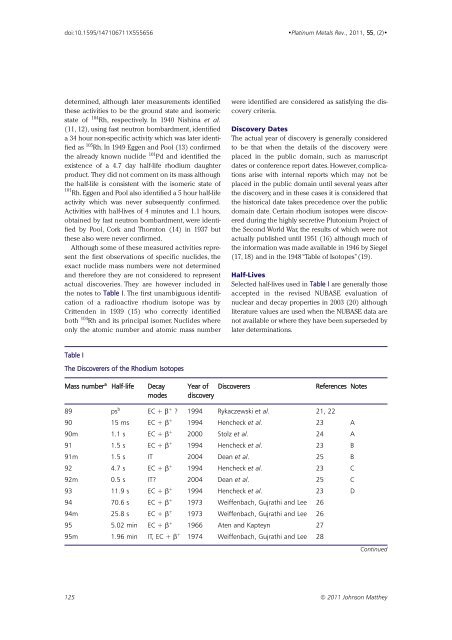Download - Platinum Metals Review
Download - Platinum Metals Review
Download - Platinum Metals Review
You also want an ePaper? Increase the reach of your titles
YUMPU automatically turns print PDFs into web optimized ePapers that Google loves.
doi:10.1595/147106711X555656<br />
•<strong>Platinum</strong> <strong>Metals</strong> Rev., 2011, 55, (2)•<br />
determined, although later measurements identified<br />
these activities to be the ground state and isomeric<br />
state of 104 Rh, respectively. In 1940 Nishina et al.<br />
(11, 12), using fast neutron bombardment, identified<br />
a 34 hour non-specific activity which was later identified<br />
as 105 Rh. In 1949 Eggen and Pool (13) confirmed<br />
the already known nuclide 101 Pd and identified the<br />
existence of a 4.7 day half-life rhodium daughter<br />
product. They did not comment on its mass although<br />
the half-life is consistent with the isomeric state of<br />
101 Rh. Eggen and Pool also identified a 5 hour half-life<br />
activity which was never subsequently confirmed.<br />
Activities with half-lives of 4 minutes and 1.1 hours,<br />
obtained by fast neutron bombardment, were identified<br />
by Pool, Cork and Thornton (14) in 1937 but<br />
these also were never confirmed.<br />
Although some of these measured activities represent<br />
the first observations of specific nuclides, the<br />
exact nuclide mass numbers were not determined<br />
and therefore they are not considered to represent<br />
actual discoveries. They are however included in<br />
the notes to Table I. The first unambiguous identification<br />
of a radioactive rhodium isotope was by<br />
Crittenden in 1939 (15) who correctly identified<br />
both 104 Rh and its principal isomer. Nuclides where<br />
only the atomic number and atomic mass number<br />
were identified are considered as satisfying the discovery<br />
criteria.<br />
Discovery Dates<br />
The actual year of discovery is generally considered<br />
to be that when the details of the discovery were<br />
placed in the public domain, such as manuscript<br />
dates or conference report dates. However, complications<br />
arise with internal reports which may not be<br />
placed in the public domain until several years after<br />
the discovery, and in these cases it is considered that<br />
the historical date takes precedence over the public<br />
domain date. Certain rhodium isotopes were discovered<br />
during the highly secretive Plutonium Project of<br />
the Second World War, the results of which were not<br />
actually published until 1951 (16) although much of<br />
the information was made available in 1946 by Siegel<br />
(17, 18) and in the 1948 “Table of Isotopes”(19).<br />
Half-Lives<br />
Selected half-lives used in Table I are generally those<br />
accepted in the revised NUBASE evaluation of<br />
nuclear and decay properties in 2003 (20) although<br />
literature values are used when the NUBASE data are<br />
not available or where they have been superseded by<br />
later determinations.<br />
Table I<br />
The Discoverers of the Rhodium Isotopes<br />
Mass number a Half-life Decay Year of Discoverers References Notes<br />
modes discovery<br />
89 ps b EC + β + ? 1994 Rykaczewski et al. 21, 22<br />
90 15 ms EC + β + 1994 Hencheck et al. 23 A<br />
90m 1.1 s EC + β + 2000 Stolz et al. 24 A<br />
91 1.5 s EC + β + 1994 Hencheck et al. 23 B<br />
91m 1.5 s IT 2004 Dean et al. 25 B<br />
92 4.7 s EC + β + 1994 Hencheck et al. 23 C<br />
92m 0.5 s IT? 2004 Dean et al. 25 C<br />
93 11.9 s EC + β + 1994 Hencheck et al. 23 D<br />
94 70.6 s EC + β + 1973 Weiffenbach, Gujrathi and Lee 26<br />
94m 25.8 s EC + β + 1973 Weiffenbach, Gujrathi and Lee 26<br />
95 5.02 min EC + β + 1966 Aten and Kapteyn 27<br />
95m 1.96 min IT, EC + β + 1974 Weiffenbach, Gujrathi and Lee 28<br />
Continued<br />
125 © 2011 Johnson Matthey
















